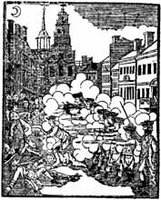Commemorating and Considering the Boston Massacre
 Wednesday, 5 March, is the 244th anniversary of the Boston Massacre, and there are a number of commemorations and discussions of the event coming up.
Wednesday, 5 March, is the 244th anniversary of the Boston Massacre, and there are a number of commemorations and discussions of the event coming up.
At 6:30 P.M. that evening, Old South Meeting-House will host a free program with authors Audrey and Frank Peterman speaking on “The Future of Our National Parks.” This talk is co-sponsored by Boston National Historical Park to celebrate its fortieth anniversary. The event description says, “The Petermans will reflect on a few of many Boston stories—including Crispus Attucks, the first person to die in the Boston Massacre, and internationally famous African American poet Phillis Wheatley—that evoke the voices and invite the participation of our diverse communities in the history that shaped our nation.”
On Saturday, 8 March, the Bostonian Society has a full day of activities at the Old State House museum commemorating the Massacre. These include the “Trial of the Century” program at 11:30 A.M. and 2:30 P.M.: “Watch patriot lawyers John Adams and Josiah Quincy defend the British soldiers accused of murdering five Bostonians at the Boston Massacre. Audience members are invited to act as witnesses and jurors for this celebrated case.” Tickets will go on sale at 9:00, and are free with Old State House admission.
At 7:00 P.M., the live reenactment of the Massacre will take place outside the Old State House. Some of the region’s best historical reenactors will portray the men of the 29th Regiment and the people of Boston as they move toward their fatal confrontation. I’ll be there as the narrator. This event is outdoors and free. Sight lines aren’t excellent, but being stuck in a crowd is part of the historical experience. Folks can also follow on Twitter through @BostonianSoc and #bostonmassacre.
Next Wednesday, 12 March, at 6:00 P.M., the Old State House will be the site of a talk on “The Legacy of Crispus Attucks in Boston in the Twentieth Century.” Maureen McAleer, a graduate student at Harvard University, will discuss her thesis work on how activists, politicians, and the public have remembered, commemorated, and used Attucks’s name over time. This event is free, but please register on Eventbrite.














